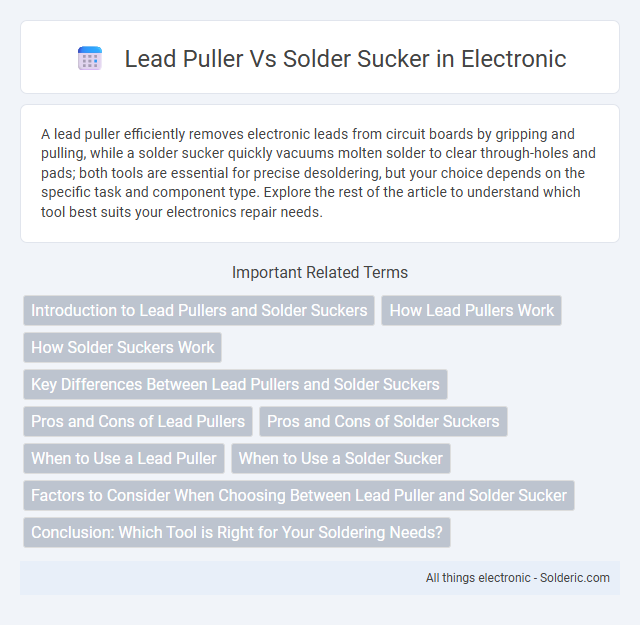A lead puller efficiently removes electronic leads from circuit boards by gripping and pulling, while a solder sucker quickly vacuums molten solder to clear through-holes and pads; both tools are essential for precise desoldering, but your choice depends on the specific task and component type. Explore the rest of the article to understand which tool best suits your electronics repair needs.
Comparison Table
| Feature | Lead Puller | Solder Sucker |
|---|---|---|
| Purpose | Removes component leads from circuit boards | Extracts molten solder from joints |
| Operation | Mechanical grip or gripping force | Vacuum suction activated by spring or pneumatic action |
| Usage | Pulls pins or leads after heating | Removes solder after melting it with a soldering iron |
| Design | Handheld gripping tool, sometimes plier-like | Cylindrical tube with push-button trigger |
| Material Compatibility | Primarily metal leads on PCBs | Molten solder of various alloys |
| Common in | Component removal tasks | Desoldering and circuit board repair |
| Efficiency | Effective for removing leads without solder | Effective for cleaning solder joints quickly |
Introduction to Lead Pullers and Solder Suckers
Lead pullers and solder suckers are essential tools for electronics repair and circuit board maintenance, designed to remove solder and components efficiently. A lead puller gently extracts component leads from holes without damaging the circuit board, while a solder sucker uses a vacuum mechanism to quickly remove molten solder from joints. Understanding the specific function of each tool helps you choose the right equipment for precise and effective solder removal tasks.
How Lead Pullers Work
Lead pullers work by gripping electronic component leads firmly with a specialized clamping mechanism that provides controlled traction to extract the leads from printed circuit boards without damaging the board or surrounding components. They utilize a manual or spring-loaded design to apply steady force, ensuring precise removal of leads from tight or delicate solder joints. This tool is essential for maintenance and repair tasks, offering a safer alternative to heat-based desoldering methods like solder suckers.
How Solder Suckers Work
Solder suckers operate using a spring-loaded or battery-powered piston that creates a rapid vacuum to efficiently remove molten solder from electronic components and circuit boards. When the nozzle is pressed against the heated solder, the vacuum force quickly pulls the liquefied solder into the chamber, ensuring a clean and precise desoldering process. This mechanism contrasts with lead pullers, which mechanically grip and extract component leads rather than removing solder material.
Key Differences Between Lead Pullers and Solder Suckers
Lead pullers and solder suckers serve distinct functions in electronics repair; lead pullers are tools designed to grip and extract component leads from circuit boards without damaging the board or components, while solder suckers are used to remove molten solder from joints during desoldering. Lead pullers typically use mechanical gripping mechanisms or spring tension to firmly pull leads, whereas solder suckers operate through vacuum suction to clear solder from connections. Understanding these key differences aids technicians in selecting the appropriate tool for either lead extraction or solder removal, ensuring efficient and precise repair work.
Pros and Cons of Lead Pullers
Lead pullers offer precise removal of component leads with minimal board damage, making them ideal for delicate electronics repair. Their main drawback is the potential for limited effectiveness on tightly soldered leads compared to solder suckers, which excel in quickly clearing molten solder. Choosing the right tool depends on your need for control versus speed when desoldering components.
Pros and Cons of Solder Suckers
Solder suckers efficiently remove molten solder, providing quick and clean desoldering, ideal for through-hole components, but they can be less effective on surface mount devices and require manual precision to avoid damaging pads. Their plastic construction often makes them lightweight and portable, though durability issues may arise with frequent use. Compared to lead pullers, solder suckers offer greater versatility in handling solder removal but lack the mechanical grip for extracting leads.
When to Use a Lead Puller
A lead puller is ideal for safely removing electronic component leads without damaging the circuit board, especially when desoldering through-hole parts. Use your lead puller when precision and control are essential to avoid stress on delicate components or pads. Compared to a solder sucker, it offers more gentle extraction, ensuring clean removal of leads during PCB repairs or modifications.
When to Use a Solder Sucker
A solder sucker is ideal when you need to quickly remove molten solder from through-hole pads or component leads during desoldering tasks. It efficiently clears excess solder, allowing you to extract leads or components without damaging the circuit board. Use a solder sucker when precision and speed are required to ensure clean and effective solder joint removal.
Factors to Consider When Choosing Between Lead Puller and Solder Sucker
When choosing between a lead puller and a solder sucker, consider the type of component removal required: lead pullers excel at extracting through-hole component leads without damaging the board, while solder suckers are ideal for removing molten solder quickly from joints. Assess the tool's ease of use, maintenance, and suction power, as solder suckers typically offer faster solder removal but may lack the precision of lead pullers. Material compatibility and workspace constraints also influence the decision, with lead pullers suited for delicate or densely packed circuits and solder suckers preferred for general rework and desoldering tasks.
Conclusion: Which Tool is Right for Your Soldering Needs?
A lead puller excels at removing large component leads cleanly from PCBs, making it ideal for desoldering through-hole components with minimal board damage. A solder sucker is more versatile for desoldering various solder joints quickly, especially in tight spaces, but may struggle with long leads or heavy solder. Choosing between a lead puller and solder sucker depends on the specific tasks: lead pullers suit precise lead extraction, while solder suckers offer rapid general-purpose solder removal.
Lead puller vs solder sucker Infographic

 solderic.com
solderic.com